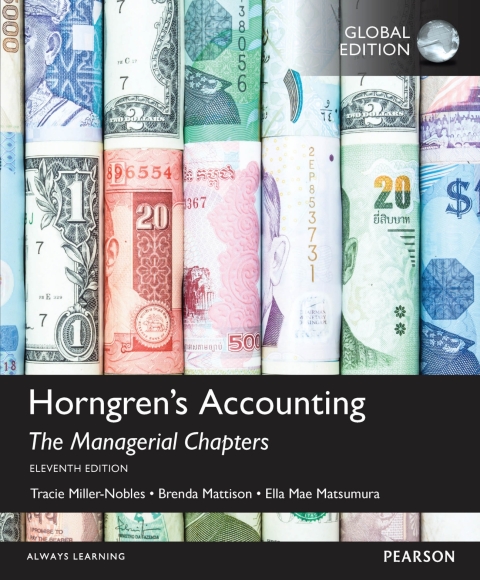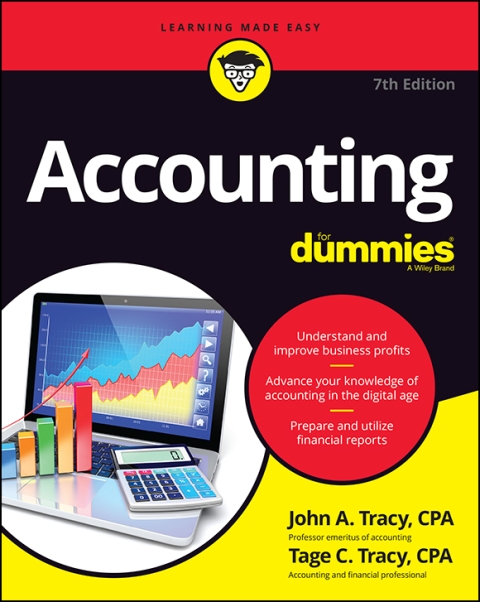Description
Efnisyfirlit
- Title Page
- Copyright Page
- About the Authors
- Contents
- Chapter 18 Introduction to Managerial Accounting
- Why Is Managerial Accounting Important?
- Financial Versus Managerial Accounting
- Management Accountability
- Today’s Business Environment
- Ethical Standards
- How Do Service, Merchandising, and Manufacturing Companies Differ?
- Service Companies
- Merchandising Companies
- Manufacturing Companies
- How Are Costs Classified?
- Direct and Indirect Costs
- Product Costs
- Prime and Conversion Costs
- How Do Manufacturing Companies Determine the Cost of Manufactured Products?
- Calculating Cost of Goods Sold
- Calculating Cost of Goods Manufactured
- Flow of Costs Through the Inventory Accounts
- Calculating Unit Product Cost
- How Is Managerial Accounting Used in Service and Merchandising Companies?
- Calculating Cost per Service
- Calculating Cost per Item
- Review
- Assess Your Progress
- Critical Thinking
- Chapter 19 Job Order Costing
- How Do Manufacturing Companies Use Job Order and Process Costing Systems?
- Job Order Costing
- Process Costing
- How Do Materials and Labor Costs Flow Through the Job Order Costing System?
- Materials
- Labor
- How Do Overhead Costs Flow Through the Job Order Costing System?
- Before the Period—Calculating the Predetermined Overhead Allocation Rate
- During the Period—Allocating Overhead
- At the End of the Period—Adjusting for Overallocated and Underallocated Overhead
- What Happens When Products Are Completed and Sold?
- Transferring Costs to Finished Goods Inventory
- Transferring Costs to Cost of Goods Sold
- How Is the Manufacturing Overhead Account Adjusted?
- Summary
- How Do Service Companies Use a Job Order Costing System?
- Review
- Assess Your Progress
- Critical Thinking
- Chapter 20 Process Costing
- How Do Costs Flow Through a Process Costing System
- Job Order Costing Versus Process Costing
- Flow of Costs Through a Process Costing System
- What Are Equivalent Units of Production, and How Are Calculated?
- Equivalent Units of Production
- Conversion Costs
- How Is a Production Cost report Prepared?
- Production Cost Report—FirstProcess—Assembly Department
- Production Cost Report—Second Process—Cutting Department
- What Journal Entries Are Required In a Process Costing System?
- Transaction 1—Raw Materials Purchased
- Transaction 2—Raw Materials Used In Production
- Transaction 3—Labor Costs Incurred
- Transaction 4—Additional Manufacturing Costs Incurred
- Transaction 5—Allocation of Manufacturing Overhead
- Transaction 6—Transfer from the Assembly Department to the Cutting Department
- Transaction 7—Transfer from Cutting Department to Finished Goods Inventory
- Transaction 8—Puzzles Sold
- Transaction 9—Adjust Manufacturing Overhead
- How Can the Production Cost Report Be Used to Make Decisions?
- APPENDIX 20A: Process Costing: First-In, First-Out Method
- How Is a Production Cost Report Prepared Using the FIFO Method?
- Comparison of Weighted-Average and FIFO Methods
- Review
- Assess Your Progress
- Critical Thinking
- Chapter 21 Cost-Volume-Profit Analysis
- How Do Costs Behave When There Is a Change in Volume?
- Variable Costs
- Fixed Costs
- Mixed Costs
- What Is Contribution Margin, and How Is It Used to Compute Operating Income?
- Contribution Margin
- Unit Contribution Margin
- Contribution Margin Ratio
- Contribution Margin Income Statement
- How Is Cost-Volume-Profit (CVP) Analysis Used?
- Assumptions
- Target Profit—Three Approaches
- Breakeven Point—A Variation of Target Profit
- CVP Graph—A Graphic Portrayal
- How Is CVP Analysis Used for Sensitivity Analysis?
- Changes in the Sales Price
- Changes in Variable Costs
- Changes in Fixed Costs
- What Are Some Other Ways CVP Analysis Can Be Used?
- Margin of Safety
- Operating Leverage
- Sales Mix
- APPENDIX 21A: Variable Costing
- How Does Variable Costing Differ From Absorption Costing?
- Absorption Costing
- Variable Costing
- Comparison of Unit Product Cost
- How Does Operating Income Differ Between Variable Costing and Absorption Costing?
- Production Equals Sales
- Production Exceeds Sales
- Production Is Less Than Sales
- Summary
- Review
- Assess Your Progress
- Comprehensive Problem for Chapters 18–21
- Critical Thinking
- Chapter 22 Master Budgets
- Why Do Managers Use Budgets?
- Budgeting Objectives
- Budgeting Benefits
- Budgeting Procedures
- Budgeting and Human Behavior
- Are There Different Types of Budgets?
- Strategic and Operational Budgets
- Static and Flexible Budgets
- Master Budgets
- How Are Operating Budgets Prepared for a Manufacturing Company?
- Sales Budget
- Production Budget
- Direct Materials Budget
- Direct Labor Budget
- Manufacturing Overhead Budget
- Cost of Goods Sold Budget
- Selling and Administrative Expense Budget
- How Are Financial Budgets Prepared for a Manufacturing Company?
- Capital Expenditures Budget
- Cash Budget
- Budgeted Income Statement
- Budgeted Balance Sheet
- Budgeted Statement of Cash Flows
- How Can Information Technology Be Used in the Budgeting Process?
- Sensitivity Analysis
- Budgeting Software
- APPENDIX 22A: Budgeting for Merchandising Companies
- How Are Operating Budgets Prepared for a Merchandising Company?
- Sales Budget
- Inventory, Purchases, and Cost of Goods Sold Budget
- Selling and Administration Expense Budget
- How Are Financial Budgets Prepared for a Merchandising Company?
- Capital Expenditures Budget
- Cash Budget
- Budgeted Income Statement
- Budgeted Balance Sheet
- Budgeted Statement of Cash Flows
- Review
- Assess Your Progress
- Critical Thinking
- Chapter 23 Flexible Budgets and Standard Cost Systems
- How Do Managers Use Budgets to Control Business Activities?
- Performance Reports Using Static Budgets
- Performance Reports Using Flexible Budgets
- Why Do Managers Use a Standard Cost System to Control Business Activities?
- Setting Standards
- Standard Cost System Benefits
- Variance Analysis for Product Costs
- How Are Standard Costs Used to Determine Direct Materials and Direct Labor Variances?
- Direct Materials Variances
- Direct Labor Variances
- How Are Standard Costs Used to Determine Manufacturing Overhead Variances?
- Allocating Overhead in a Standard Cost System
- Variable Overhead Variances
- Fixed Overhead Variances
- What Is the Relationship Among the Product Cost Variances, and Who Is Responsible for Them?
- Variance Relationships
- Variance Responsibilities
- How Do Journal Entries Differ in a Standard Cost System?
- Journal Entries
- Standard Cost Income Statement
- Review
- Assess Your Progress
- Critical Thinking
- Chapter 24 Cost Allocation and Responsibility Accounting
- How Do Companies Assign and Allocate Costs
- Single Plantwide Rate
- Multiple Department Rates
- Activity-Based Costing
- Traditional Costing Systems Compared with ABC Systems
- Why Do Decentralized Companies Need Responsibility Accounting?
- Advantages of Decentralization
- Disadvantages of Decentralization
- Responsibility Accounting
- What Is a Performance Evaluation System, and How Is It Used?
- Goals of Performance Evaluation Systems
- Limitations of Financial Performance Measurement
- The Balanced Scorecard
- How Do Companies Use Responsibility Accounting to Evaluate Performance in Cost, Revenue, and Profit
- Controllable Versus Noncontrollable Costs
- Responsibility Reports
- How Does Performance Evaluation in Investment Centers Differ From Other Centers?
- Return on Investment (ROI)
- Residual Income (RI)
- Limitations of Financial Performance Measures
- APPENDIX 24A: Transfer Pricing
- How Do Transfer Prices Affect Decentralized Companies?
- Objectives in Setting Transfer Prices
- Setting Transfer Prices
- Review
- Assess Your progress
- Comprehensive Problem for Chapters 22–24
- Critical Thinking
- Chapter 25 Short-Term Business Decisions
- How Is Relevant Information Used to Make Short-Term Decisions?
- Relevant Information
- Relevant Nonfinancial Information
- Differential Analysis
- How Does Pricing Affect Short-Term Decisions?
- Setting Regular Prices
- Special Pricing
- How Do Managers Decide Which Products to Produce and Sell?
- Dropping Unprofitable Products and Segments
- Product Mix
- Sales Mix
- How Do Managers Make Outsourcing and Processing Further Decisions?
- Outsourcing
- Sell or Process Further
- Review
- Assess Your Progress
- Critical Thinking
- Chapter 26 Capital Investment Decisions
- What Is Capital Budgeting?
- The Capital Budgeting Process
- Focus on Cash Flows
- How Do the Payback and Accounting Rate of Return Methods Work?
- Payback
- Accounting Rate of Return (ARR)
- What Is the Time Value of Money?
- Time Value of Money Concepts
- Present Value of a Lump Sum
- Present Value of an Annuity
- Summary
- How Do Discounted Cash Flow Methods Work?
- Net Present Value (NPV)
- Internal Rate of Return (IRR)
- Comparing Capital Investment Analysis Methods
- Sensitivity Analysis
- Capital Rationing
- Review
- Assess Your Progress
- Comprehensive Problem for Chapters 25–26
- Critical Thinking
- APPENDIX A—2013 Green Mountain Coffee Roasters, Inc. Annual Report
- APPENDIX B—Present Value Tables
- APPENDIX C—The Statement of Cash Flows
- APPENDIX D—Financial Statement Analysis
- GLOSSARY
- A
- B
- C
- D
- E
- F
- G
- H
- I
- J
- K
- L
- M
- N
- O
- P
- R
- S
- T
- U
- V
- W
- INDEX
- A
- B
- C
- D
- F
- G
- H
- I
- J
- K
- L
- M
- N
- O
- P
- Q
- R
- S
- T
- U
- V
- W
- PHOTO CREDITS






Reviews
There are no reviews yet.